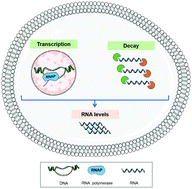Methods for the analysis of transcriptome dynamics
Abstract
The transcriptome is the complete set of transcripts in a cell or tissue and includes ribosomal RNA (rRNA), messenger RNA (mRNA), transfer RNA (tRNA), and regulatory noncoding RNA. At steady-state, the transcriptome results from a compensatory variation of the transcription and decay rate to maintain the RNA concentration constant. RNA transcription constitutes the first stage in gene expression, and thus is a major and primary mode of gene expression control. Nevertheless, regulation of RNA decay is also a key factor in gene expression control, involving either selective RNA stabilization or enhanced degradation. Transcriptome analysis allows the identification of gene expression alterations, providing new insights regarding the pathways and mechanisms involved in physiological and pathological processes. Upon perturbation of cell homeostasis, rapid changes in gene expression are required to adapt to new conditions. Thus, to better understand the regulatory mechanisms associated with gene expression alterations, it is vital to acknowledge the relative contribution of RNA synthesis and decay to the transcriptome. To the toxicology field, the study of gene expression regulation mechanisms can help identify the early and mechanistic relevant cellular events associated with a particular response. This review aims to provide a critical comparison of the available methods used to analyze the contribution of RNA transcription and decay to gene expression dynamics. Notwithstanding, an integration of the data obtained is necessary to understand the entire repercussions of gene transcription changes at a system-level. Thus, a brief overview of the methods available for the integration and analysis of the data obtained from transcriptome analysis will also be provided.



 Please wait while we load your content...
Please wait while we load your content...